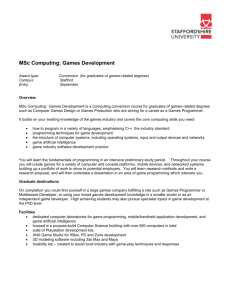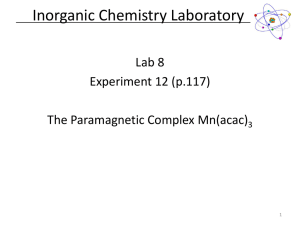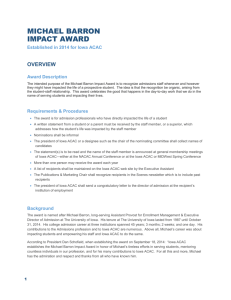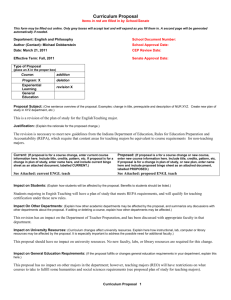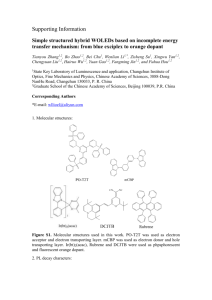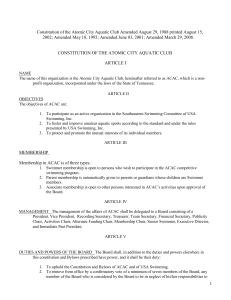The Proposal for CAHSS Career Intergration
advertisement
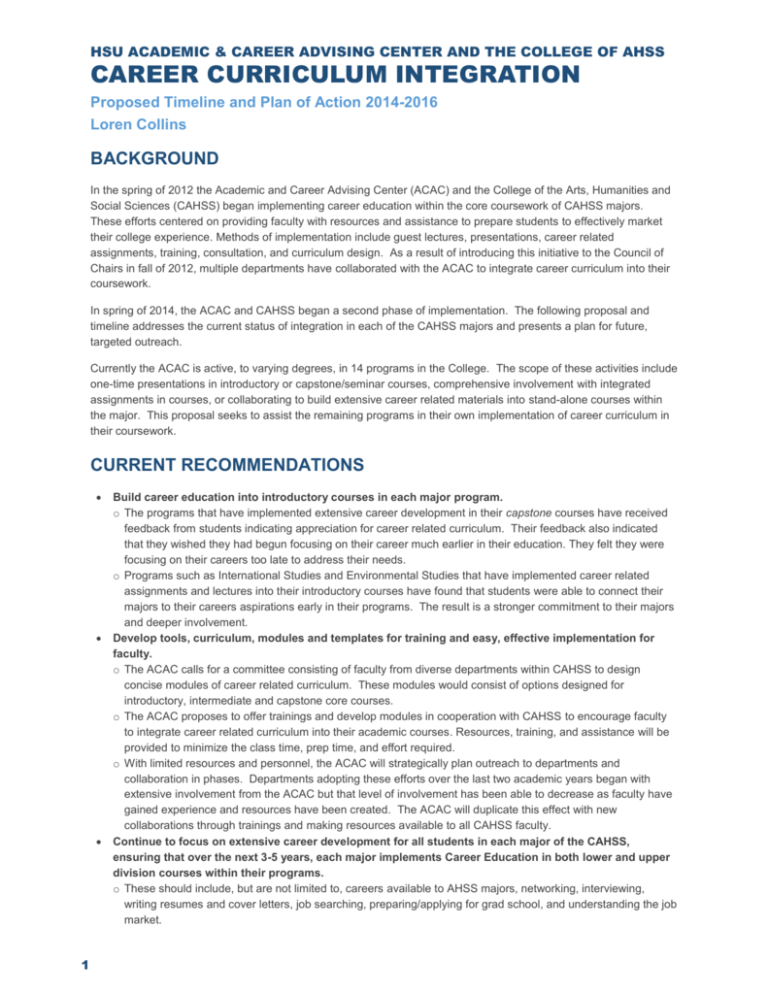
HSU ACADEMIC & CAREER ADVISING CENTER AND THE COLLEGE OF AHSS CAREER CURRICULUM INTEGRATION Proposed Timeline and Plan of Action 2014-2016 Loren Collins BACKGROUND In the spring of 2012 the Academic and Career Advising Center (ACAC) and the College of the Arts, Humanities and Social Sciences (CAHSS) began implementing career education within the core coursework of CAHSS majors. These efforts centered on providing faculty with resources and assistance to prepare students to effectively market their college experience. Methods of implementation include guest lectures, presentations, career related assignments, training, consultation, and curriculum design. As a result of introducing this initiative to the Council of Chairs in fall of 2012, multiple departments have collaborated with the ACAC to integrate career curriculum into their coursework. In spring of 2014, the ACAC and CAHSS began a second phase of implementation. The following proposal and timeline addresses the current status of integration in each of the CAHSS majors and presents a plan for future, targeted outreach. Currently the ACAC is active, to varying degrees, in 14 programs in the College. The scope of these activities include one-time presentations in introductory or capstone/seminar courses, comprehensive involvement with integrated assignments in courses, or collaborating to build extensive career related materials into stand-alone courses within the major. This proposal seeks to assist the remaining programs in their own implementation of career curriculum in their coursework. CURRENT RECOMMENDATIONS 1 Build career education into introductory courses in each major program. o The programs that have implemented extensive career development in their capstone courses have received feedback from students indicating appreciation for career related curriculum. Their feedback also indicated that they wished they had begun focusing on their career much earlier in their education. They felt they were focusing on their careers too late to address their needs. o Programs such as International Studies and Environmental Studies that have implemented career related assignments and lectures into their introductory courses have found that students were able to connect their majors to their careers aspirations early in their programs. The result is a stronger commitment to their majors and deeper involvement. Develop tools, curriculum, modules and templates for training and easy, effective implementation for faculty. o The ACAC calls for a committee consisting of faculty from diverse departments within CAHSS to design concise modules of career related curriculum. These modules would consist of options designed for introductory, intermediate and capstone core courses. o The ACAC proposes to offer trainings and develop modules in cooperation with CAHSS to encourage faculty to integrate career related curriculum into their academic courses. Resources, training, and assistance will be provided to minimize the class time, prep time, and effort required. o With limited resources and personnel, the ACAC will strategically plan outreach to departments and collaboration in phases. Departments adopting these efforts over the last two academic years began with extensive involvement from the ACAC but that level of involvement has been able to decrease as faculty have gained experience and resources have been created. The ACAC will duplicate this effect with new collaborations through trainings and making resources available to all CAHSS faculty. Continue to focus on extensive career development for all students in each major of the CAHSS, ensuring that over the next 3-5 years, each major implements Career Education in both lower and upper division courses within their programs. o These should include, but are not limited to, careers available to AHSS majors, networking, interviewing, writing resumes and cover letters, job searching, preparing/applying for grad school, and understanding the job market. Objective 1: Increase Exposure and Awareness for Faculty and Departments on the possibilities of Collaboration and Resources for Integration of Career Curriculum. Presentation to the Council of Chairs in Fall 2014; to include overview of activities already occurring in departments, preview of modules/templates for career curriculum, discussion of the importance of integrating career planning and conceptualization into introductory courses. o Provide an overview of the various models of integration currently used including presentations; creating assignments and curriculum in major core courses from introductory to capstone level; stand-alone courses; and collaborative one-day required workshops. o Introduce a proposal to develop, through an interdisciplinary committee, modules of career related curriculum designed to easily be inserted in introductory, intermediate and capstone level core courses within each major. Equipping faculty with resources to implement career curriculum in required courses for their majors beginning with introductory courses through senior seminars, capstones, or stand-alone workshops. S committee consisting of ACAC staff and CAHSS faculty will be formed with the purpose of creating career curriculum modules/templates for use in introductory, intermediate, and capstone level core courses. Partner with the CAHSS on creating training opportunities for faculty focusing on career education in the classroom. This will include, but not be limited to, a 7 minute micro-presentation at the Spring Institute for Student Success on discusses careers for AHSS majors and applying broad AHSS skills to employment. Coordinate with each department to review the Career Guide for their major, provide opportunities for faculty to link to the Career Guide and career resources to their website to provide students and faculty with resources in a central location for each major. Objective 2: Targeted Outreach to Departments The order of implementation for the programs in the CAHSS will be determined by department chairs and will account for simultaneous program development processes. Additionally, the timeline represents an ideal based on current staffing levels and circumstances which are also subject to change. Fall 2014 Form a joint committee of faculty and ACAC staff with the purpose of developing career related curriculum. First modules to be created for introductory level courses. Begin collaboration with 2-3 departments, to be determined by department chairs, not currently working with the ACAC/implementing career education in their courses. Spring 2015 Joint committee of faculty and ACAC staff to begin development of the second set of modules targeting intermediate level courses. Begin adoption of modules for introductory level courses in academic departments that select the module based method of career integration. Begin collaboration with 2-3 departments, to be determined by department chairs, not currently working with the ACAC/implementing career education in their courses. Fall 2015 Joint committee of faculty and ACAC staff to begin development of the third set of modules targeting capstone level courses. Begin adoption of modules for intermediate level courses in academic departments that select the module based method of career integration. Begin collaboration with 2-3 departments, to be determined by department chairs, not currently working with the ACAC/implementing career education in their courses. Spring 2016 Begin implementation of modules for capstone courses in academic departments that select the module based method of career integration. Review degrees of integration into introductory courses, capstone courses, and other methodologies in AHSS. Identify any existing areas of needs in departments and evaluate effectiveness of existing efforts. 2
